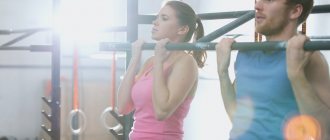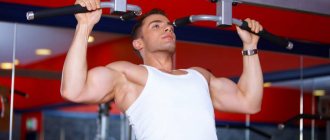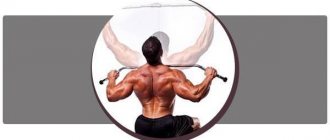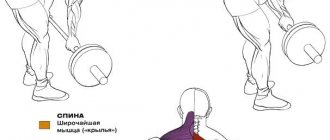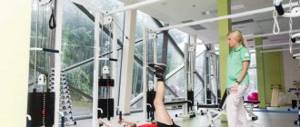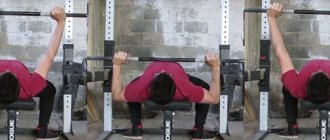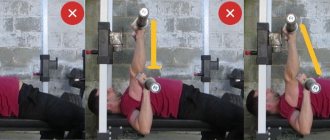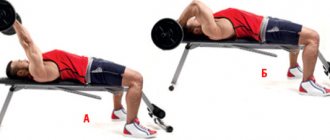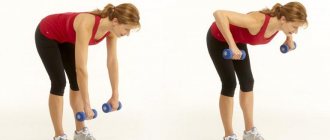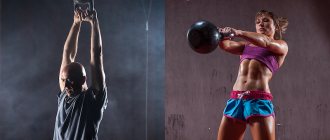What muscles does the reverse grip bench press work?
The main part of the load in the bench press with a reverse grip falls on the upper
(clavicular)
part of the pectoral muscles.
It is due to their contraction that the initial phase of lifting the barbell upward occurs.
Next, the front heads of the deltoids .
And the last to be included in the work are
the triceps
.
Due to their reduction, the “pressure” phase occurs. Also, when performing this press, the biceps
. It can be felt when the barbell is lowered. It acts as a stabilizer for the elbow and shoulder joints and also flexes the arm. In addition to the main ones, stabilizer muscles are involved in the exercise. These include:
- Leg muscles. They stabilize the lower body, giving us a more stable position on the bench.
- Back muscles. Responsible for the position of the shoulder blades.
Contraindications for athletes
However, standing biceps curls with a reverse grip may not be useful for all athletes. And there are reasons for this. There are a number of contraindications to performing this exercise. First of all, these are lateral and medial epicondylitis and degenerative injuries of the elbow joints, ligaments and tendons. If you experience these or similar problems, doing barbell curls with a reverse grip will be accompanied by severe pain, even no warming or pain-relieving ointments will help. “Hammers” with dumbbells are also not recommended for such ailments.
Benefits of the Reverse Press
- This exercise allows you to work the upper pectoral muscles. Which are precisely behind in development. An experiment was conducted to compare the effectiveness of an INCLINE PRESS with a reverse grip. At the end there was an interesting conclusion. That the reverse grip engages the upper pectoral muscles 30% more.
- When performing this press, the shoulder moves along its natural trajectory. This makes the exercise more comfortable. And reduces the risk of pinching the supraspinatus muscle.
- A reverse grip prevents us from moving our elbows too far to the side. Consequently, the exercise is performed with more correct technique. At the same time, the load on the elbow joints is reduced.
- Triceps do not take most of the load on themselves. Thus giving the opportunity to work the pectoral muscles in a more isolated manner. Especially if we perform the exercise with partial amplitude and do not fully straighten our arms.
- This press is perfect for beginners. Since the trajectory of movement is very difficult to change. Unlike the classic bench press.
- The load on the wrist joint is reduced. Since it is much more difficult to rotate the hand with such a grip. Of course, at first this grip may be unusual for you.
As you can see, this bench press can be useful for athletes of any fitness level. Giving the opportunity to install equipment. It can also be used by athletes who have shoulder injuries. We are not talking about fractures and ruptures. But small inflammations, which do not allow us to work calmly in the classical style, are precisely among such injuries. And of course, reducing the load on the elbow and wrist joints.
Smith machine
The design of the Smith simulator (or machine) allows you to perform exercises only with a limited amplitude. Amplitude regulators are special limiters. The essence of the work of the simulator is to provide the athlete with stability of the weight when performing a particular exercise. These same limiters perform a safety role - they replace the second person, who, as a rule, monitors your safety during the training process.
Thanks to special stabilizer hooks, a novice athlete should not be afraid that he may not be able to withstand the set weight.
Video: Smith machine design and functionality
The main purpose of such a simulator is to perform bench presses in a sitting, lying or standing position, squats and other exercises. The Smith machine allows you to strengthen large muscles and entire muscle groups.
Execution technique
In this type of bench press, technique plays a very important role. Since the reverse grip is considered not the most reliable and there is a risk of the bar falling. To prevent this from happening, you need to position the bar correctly. It should lie slightly diagonally, closer to the base of the palm. Such a grip will not allow the wrist to bend strongly in the opposite direction.
Initial position:
- The exercise is performed on a regular bench press.
- It is very important to choose the right bar height. It needs to be placed a little lower than with a classic bench press. That is, when removing the barbell, your arms should be bent at the elbow joints.
- We lie down on the bench. We bring the shoulder blades together and lower them down. The pelvis is pressed against the bench. There is a slight arch in the lower back. There is no need to do a bridge, unless of course you plan to press the barbell in a powerlifting style.
- Legs are spread apart. Feet should be completely flat on the floor. No need to put them on the toe. This can affect your resilience.
- The bar is at eye level. We grab it with a reverse grip. Let's not forget what we talked about earlier. The bar lies closer to the base of the palms. 4 fingers wrap around the bar on one side, and the thumb on the other. Hands are positioned slightly wider than shoulders.
- Exhale and remove the bar from the racks. We bring it forward until the bar is at the level of the middle of the pectoral muscles.
Performance:
- From the starting position, while inhaling, we begin to lower the barbell to the lower part of the pectoral muscles. In this exercise, the trajectory of the barbell is set itself, so you don’t have to worry about it. The main thing is to feel the stretch in the pectoral muscles.
- After the bar touches the bottom of the pecs, together with the exhalation we squeeze the barbell to the starting position.
There is one popular exercise that is mechanically similar to the reverse grip press. We are talking about CLOSING THE HANDS IN A CROSSOVER FROM THE LOWER BLOCK. If you have performed it before, then mastering the reverse press technique will be much easier for you.
Recommendations for implementation
- It is important that the bar goes down, describing a semicircle. We start the movements from the middle of the pectoral muscles, and lower them to their lower part.
- During movement, the elbows should be pressed to the body. There is no need to move them apart. This will place additional stress on the elbow joints and can lead to injury. If you cannot work with this technique, then you have taken too much weight.
- There is no need to lower the barbell to the top of your chest. This will not help you increase the load on that muscle group. At the same time, the risk of dropping the bar increases. The same applies to lowering to the stomach. This technique greatly overloads the deltas.
- We press the bar up, twice as fast as we lowered it. This will allow you to properly feel the stretching of all the muscles involved in the movement. And it will create a peak load during the bench press itself.
- In order to minimize the risk of the bar falling, it is worth performing the exercise with a partner. Who will insure you and at the right moment, will be able to pick up the barbell or help you push it up.
- Never use an open grip. The thumb must be wrapped around the bar. This is your insurance that will prevent the bar from falling.
- Don't bend your wrists too much. This way you will only injure them.
Let's consolidate the above. We press the barbell under control. We try to feel the work of the target muscles. We do not spread our elbows to the sides. Lower the barbell to the bottom of your chest. Don't forget to breathe correctly. Inhale as you lower, exhale as you push.
The intensity is higher![edit | edit code]
Use the following techniques to increase the intensity of your training in exercises marked with the following symbol: Hi. Use techniques only in the last two sets of the exercise.
- Forced repetitions (FR)
After “failure”, complete 2-3 additional repetitions with the help of a partner. It should help you overcome the short starting section of the amplitude. Next you must press the weight yourself.
- Peak contraction (PS)
At the end point of the amplitude, pause and hold the weight statically for 5 seconds. Achieve the most powerful static contraction of the pectoral muscles.
- Rest-pause (RP)
Choose a weight that you can do no more than 5-6 reps with. Do 2-3 reps, rest for 20 seconds and do another 2-3 reps. Again, rest for 20 seconds and do as many reps as you can. Rest again for 20 seconds and finish off the last few reps.
- Drop sets (DS)
Once you reach failure, reduce the working weight by 10-15% and do an additional set until failure. Next, again reduce the working weight by 5-10% and perform a new set until failure.
Source Muscle and Fitness Magazine No. 6
Reverse Grip Press Variations
Reverse grip press with dumbbells
Reverse press can be performed with dumbbells. This option allows you to work each pectoral muscle independently of each other. This makes it possible to reduce the imbalance in their development. This is especially true in the initial stages. Also, working with dumbbells implies the inclusion of a large number of small stabilizer muscles. Thanks to this, they are strengthened. Giving us the opportunity to increase working weights in basic exercises. As for the load on the wrist joints, it will be less than when working with a barbell. Since when working with dumbbells, it allows you to rotate the hand in any direction. Therefore, we can choose a position in which we will not experience discomfort or pain in the wrists. The rest of the technique is the same as in the version with a barbell.
Smith Machine Reverse Grip Press
The Smith machine allows you to work the pectoral muscle in more isolation. Since the barbell is secured on both sides, we don’t have to worry about dropping it in the wrong place. Also, this simulator is equipped with special safety stops. Therefore, you can safely perform the bench press without a partner without fear of dropping the barbell on your chest. But among all the advantages, there is one small disadvantage. I said earlier that we press the barbell along an arcuate path. In the Smith simulator, we cannot do this. Consequently, the bar will rise and fall along a trajectory that is not entirely natural for us. In the lowest position, the elbow joint will be pinched. This problem can be solved by shortening the amplitude. That is, we do not lower the bar all the way down and do not press it completely. The amplitude will be different for everyone. You need to start from your feelings.
Hummer Reverse Press
Lever simulators are no longer uncommon. Increasingly, athletes are using them in their training. Performing the bench press with a reverse grip is very comfortable. The pectoral muscles will be worked in isolation, by excluding the stabilizer muscles. We no longer need to worry about dropping a burden on ourselves. The bench press in a lever machine occurs in an arcuate amplitude, unlike Smith. Therefore, the movement will be more natural for us. And of course, we can work without a partner, even with heavy weight. It is believed that hummers are inferior in effectiveness to basic exercises. Therefore, it will be much more difficult to build muscle mass with their help. But if you want to score muscles at the end of a workout, then the hummer has practically no equal.
Introduction[edit | edit code]
Training for the pectoral muscles
Surely, in the old fashioned way, you relied on the bench press and now every time you push to squeeze as much as possible. It is known in advance that the working weights in this exercise arrive slowly. It’s good if you manage to put on at least a couple of kilograms in a month. Why be surprised at the slow growth of breast mass? Meanwhile, bodybuilding is not about building a termite mound. Leave the painstaking work of many years to the ants. The breakthrough to the masses must be decisive, like a tank breakthrough! In other words, the science of winning has changed dramatically since the beginning of the new millennium. Today, the pecs are being massacred, and the bench press is being used as a last resort tool. In the first place is the complex rhythm of periodization, when one workout for the pectoral muscles is completely different from the other. The pectoral muscles each time receive a blow from an unexpected direction, and therefore the usual adaptation mechanisms, which in the past forced one to stagnate in one place for months, are powerless. To withstand the heavy fire of diverse power loads, it is not enough for the body to force the secretion of anabolic hormones. With a new training regimen, this tried-and-true lifesaver simply doesn’t have time to work. Well, therefore, the muscles pull out their last trump card from their sleeve, the existence of which until recently we knew absolutely nothing. We are talking about the activation of special anabolic genes. Thanks to science! She conducted countless experiments and finally discovered a way to attack the root cause of muscle growth - our genotype. Injections in the buttock are a thing of the past! Genes, or more precisely, periodization schemes, grow muscles faster than any steroids! So, according to the new recipe, you won’t recognize your breasts in the mirror in a month! In short, hurry up to jump on the bandwagon of the high-speed scientific express, and it will take you to your destination incomparably faster than the old gelding of the old method, which today can barely move its legs under you!
Tips for maximum efficiency
- Before doing a reverse press, you should perform a set of WARM-UP EXERCISES. Particular attention should be paid to the elbow, shoulder and wrist joints.
- Before increasing the weight, you need to work out the execution technique.
- Use wrist wraps to secure your wrist.
- If you want to increase the work on your upper chest, you can do incline presses.
- If you want to maximally load the pectoral muscles, then you should use a grip wider than your shoulders. With a narrower arm position, the triceps will take on most of the load.
- The exercise should be performed in the middle range of repetitions, 8-12 times per set.
In my opinion, the reverse grip press has a place in every athlete's training program. Yes, it is less popular than other exercises. But this does not mean that it is completely ineffective. The main thing is to understand the technique of execution. Choose the right weight and avoid technical errors.
Good luck to everyone in your training!
Training program
Pumping the pectoral muscle region using a barbell press with a reverse grip is performed according to the following scheme:
- 2 training sessions per week on Monday and Friday;
- maximum number of approaches – 4;
- the maximum number of repetitions in a set is 12;
- can be used in conjunction with the classic bench press in supersets;
- Duration of training without a long break is 10 weeks.
The reverse grip barbell press is recommended for athletes who experience discomfort when using dumbbells and lever exercise machines.
